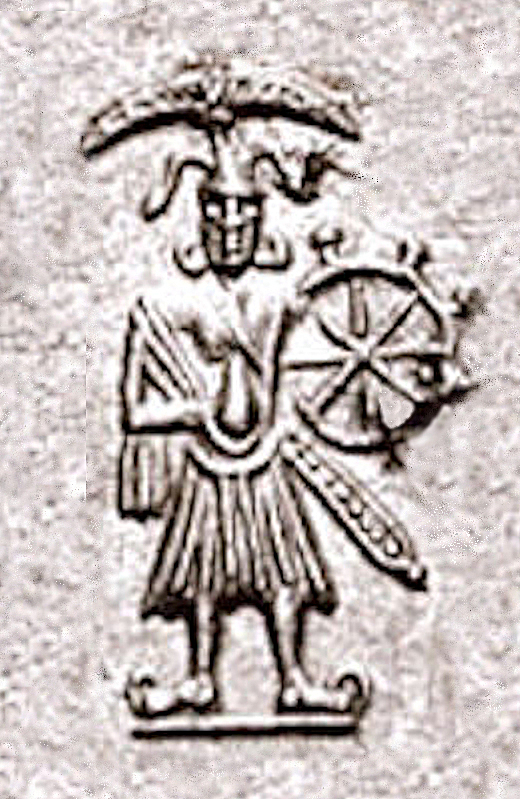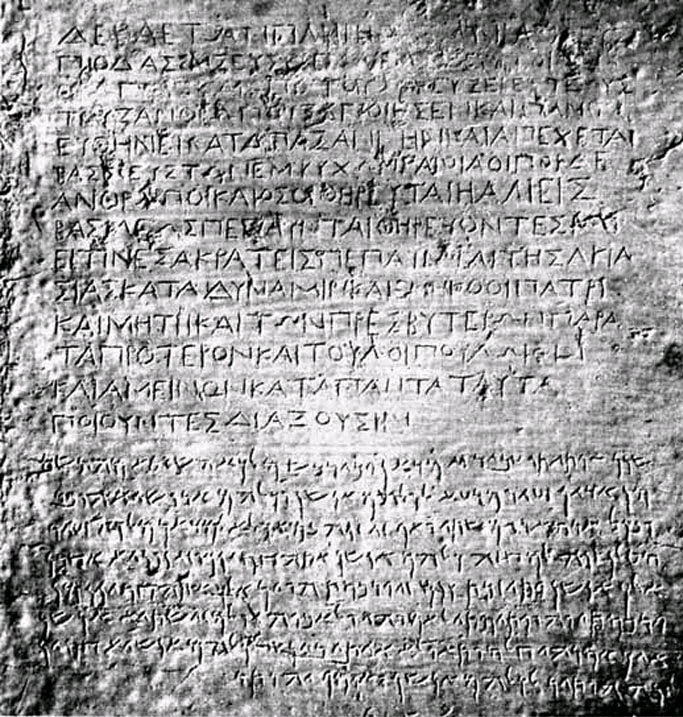|
Vāsudeva Krishna
Vāsudeva (; ), later incorporated as Vāsudeva-Krishna (, "Krishna, son of Vasudeva"),"While the earliest piece of evidence do not yet use the name Krsna...." in At the time of the Heliodorus pillar dedication to Vāsudeva in 115 BCE: "The real question, however, remains: was Vãsudeva already identified with Krsna?" Krishna-Vāsudeva or simply Krishna, was the son of Vasudeva Anakadundubhi, king of the Vrishnis in the region of Mathura. He was a leading member of the legendary Vrishni heroes, and may well have been a historical ruler in the region of Mathura.Vāsudeva and Krishna "may well have been kings of this dynasty as well" in Vāsudevism arose with the decline of Vedism in India, which occurred during the 8th to 6th century BCE. Vāsudeva then became the object of one of the earliest forms of personal deity worship in India, and is attested from around the 4th century BCE. At that time, Vāsudeva was already considered as a deity, as he appears in Pāṇini's writin ... [...More Info...] [...Related Items...] OR: [Wikipedia] [Google] [Baidu] |
Deity Krishna-Vasudeva On A Coin Of Agathocles Of Bactria 190-180 BCE
A deity or god is a supernatural being considered to be sacred and worthy of worship due to having authority over some aspect of the universe and/or life. The ''Oxford Dictionary of English'' defines ''deity'' as a God (male deity), god or goddess, or anything revered as divine. C. Scott Littleton defines a deity as "a being with powers greater than those of ordinary humans, but who interacts with humans, positively or negatively, in ways that carry humans to new Higher consciousness, levels of consciousness, beyond the grounded preoccupations of ordinary life". Religions can be categorized by how many deities they worship. Monotheism, Monotheistic religions accept only one deity (predominantly referred to as "God"), whereas Polytheism, polytheistic religions accept multiple deities. Henotheism, Henotheistic religions accept one God, supreme deity without denying other deities, considering them as aspects of the same divine principle. Nontheistic religions deny any supreme eter ... [...More Info...] [...Related Items...] OR: [Wikipedia] [Google] [Baidu] |
Vrishni
The Vrishnis (, ) were an ancient Indian clan who were believed to be the descendants of Vrishni. It is believed that Vrishni was the son of Satvata, a descendant of Yadu, the son of Yayati. He had two wives, Gandhari and Madri, not to be confused with Gandhari and Madri from the Mahabharata. He has a son named Devamidhusha by his wife Madri. Vasudeva, the father of Krishna was the grandson of Devamidhusha. According to the Puranas, the Vrishnis were residents of Dvaraka. Migration of Vrishnis to Dvaraka Jarasandha, father-in-law of Kamsa, invaded Mathura with a vast army; and though Krishna destroyed his army of demons, another asura, Kalayavan by name, surrounded Mathura with another army of thirty million monstrous fiends. Then Krishna thought it well to depart to Dvaraka. Sister Nivedita & Ananda K. CoomaraswamyMyths and Legends of the Hindus and Bhuddhists Kolkata, 1913 End of the Vrishnis After the death of Duryodhana in Mahabharata, Krishna received the curse of G ... [...More Info...] [...Related Items...] OR: [Wikipedia] [Google] [Baidu] |
Mahabharata
The ''Mahābhārata'' ( ; , , ) is one of the two major Sanskrit Indian epic poetry, epics of ancient India revered as Smriti texts in Hinduism, the other being the ''Ramayana, Rāmāyaṇa''. It narrates the events and aftermath of the Kurukshetra War, a war of succession between two groups of princely cousins, the Kauravas and the Pandava, Pāṇḍavas. It also contains Hindu philosophy, philosophical and devotional material, such as a discussion of the four "goals of life" or ''puruṣārtha'' (12.161). Among the principal works and stories in the ''Mahābhārata'' are the ''Bhagavad Gita'', the story of Damayanti, the story of Shakuntala, the story of Pururava and Urvashi, the story of Savitri and Satyavan, the story of Kacha (sage), Kacha and Devayani, the story of Rishyasringa and an Ramopakhyana, abbreviated version of the ''Rāmāyaṇa'', often considered as works in their own right. Traditionally, the authorship of the ''Mahābhārata'' is attributed to Vyasa, Vy ... [...More Info...] [...Related Items...] OR: [Wikipedia] [Google] [Baidu] |
Yadavas
The Yadava (), not to be confused with Yadav, were an ancient Indian people who believed to have descended from Yadu, a legendary king of Chandravamsha lineage. The community was formed of various clans, being the Satvatas, Andhakas, Bhojas, Kukuras, Vrishni, Surasenas, and Abhira who all worshipped Krishna. They are listed in ancient Indian literature as the segments of the lineage of Yadu (''Yaduvamsha'').Thapar, Romila (1978, reprint 1996). ''Ancient Indian Social History: Some Interpretations'', New Delhi: Orient Longman, , p. 223. Amongst the Yadava clans mentioned in ancient Indian literature, the Haihayas are believed to have descended from Sahasrajit, elder son of YaduPargiter, F. E. (1972) 922 ''Ancient Indian Historical Tradition'', Delhi: Motilal Banarsidass, p. 87. and all other Yadava clans, which include the Chedis, the Vidarbhas, the Satvatas, the Andhakas, the Kukuras, the Bhojas, the Vrishnis and the Surasenas are believed to have descended from Kr ... [...More Info...] [...Related Items...] OR: [Wikipedia] [Google] [Baidu] |
Lakshmi
Lakshmi (; , , sometimes spelled Laxmi, ), also known as Shri (, , ), is one of the principal goddesses in Hinduism, revered as the goddess of wealth, fortune, prosperity, beauty, fertility, sovereignty, and abundance. She along with Parvati and Sarasvati, form the trinity of goddesses called the Tridevi. Lakshmi has been a central figure in Hindu tradition since pre-Buddhist times (1500 to 500 BCE) and remains one of the most widely worshipped goddesses in the Hindu pantheon. Although she does not appear in the earliest Vedic literature, the personification of the term '' shri''—auspiciousness, glory, and high rank, often associated with kingship—eventually led to the development of Sri-Lakshmi as a goddess in later Vedic texts, particularly the ''Shri Suktam''. Her importance grew significantly during the late epic period (around 400 CE), when she became particularly associated with the preserver god Vishnu as his consort. In this role, Lakshmi is seen as the ide ... [...More Info...] [...Related Items...] OR: [Wikipedia] [Google] [Baidu] |
Shri
Shri (; , ) is a Sanskrit term denoting resplendence, wealth and prosperity, primarily used as an honorific. The word is widely used in South and Southeast Asian languages such as Assamese, Meitei ( Manipuri), Marathi, Malay (including Indonesian and Malaysian), Javanese, Balinese, Sundanese, Sinhalese, Thai, Tamil, Telugu, Odia, Assamese, Punjabi, Hindi, Bengali, Nepali, Malayalam, Kannada, Sanskrit, Pali, Khmer, and also among Philippine languages. It is usually transliterated as ''Sri'', ''Sree'', ''Shri'', ''Shiri'', ''Shree'', ''Si'', or ''Seri'' based on the local convention for transliteration. In Tamil it evolved to Tiru. The term is used in Indian subcontinent and Southeast Asia as a polite form of address equivalent to the English "Mr." in written and spoken language. "Shri" is also used as a title of veneration for deities or as honorific title for individuals. "Shri" is also an epithet for Hindu goddess Lakshmi, while a '' yantra'' or a mystica ... [...More Info...] [...Related Items...] OR: [Wikipedia] [Google] [Baidu] |
Narayana
Narayana (, ) is one of the forms and epithets of Vishnu. In this form, the deity is depicted in yogic slumber under the celestial waters, symbolising the masculine principle and associated with his role of creation. He is also known as Purushottama, and is considered the Supreme Being in Vaishnavism. Etymology Narayan Aiyangar states the meaning of the Sanskrit word 'Narayana' can be traced back to the Laws of Manu (also known as the ''Manusmriti'', a ''Dharmaśāstra'' text), which states: This definition is used throughout post-Vedic literature such as the ''Mahabharata'' and the ''Vishnu Purana''. 'Narayana' is also defined as the 'son of the primeval man', and 'Supreme Being who is the foundation of all men'. *'Nara' (Sanskrit नार) means 'water' and 'man' *'Yana' (Sanskrit यान) means 'vehicle', 'vessel', or more loosely, 'abode' or 'home' L. B. Keny proposes that Narayana was associated with the Dravidian, and ultimately, the Indus Valley Civilis ... [...More Info...] [...Related Items...] OR: [Wikipedia] [Google] [Baidu] |
Indo-Greeks
The Indo-Greek Kingdom, also known as the Yavana Kingdom, was a Hellenistic-era Greek kingdom covering various parts of modern-day Afghanistan, Pakistan and northwestern India. The term "Indo-Greek Kingdom" loosely describes a number of various Hellenistic states, ruling from regional capitals like Taxila, Sagala, Pushkalavati, and Bagram. Other centers are only hinted at; e.g. Ptolemy's '' Geographia'' and the nomenclature of later kings suggest that a certain Theophilus in the south of the Indo-Greek sphere of influence may also have had a royal seat there at one time. The kingdom was founded when the Graeco-Bactrian king Demetrius I of Bactria invaded India from Bactria in about 200 BC. The Greeks to the east of the Seleucid Empire were eventually divided to the Graeco-Bactrian Kingdom and the Indo-Greek Kingdoms in the North Western Indian Subcontinent. During the two centuries of their rule, the Indo-Greek kings combined the Greek and Indian languages and symb ... [...More Info...] [...Related Items...] OR: [Wikipedia] [Google] [Baidu] |
Heliodorus (ambassador)
Heliodorus is a Greek name meaning "Gift of the Sun". Several persons named Heliodorus are known to us from ancient times, the best known of which are: *Heliodorus (minister) a minister of Seleucus IV Philopator c. 175 BC * Heliodorus of Athens ancient author who wrote fifteen books on the Acropolis of Athens, possibly about 150 BC *Heliodorus (ambassador), a Greek ambassador who erected famous votive Heliodorus pillar around 110 BC near Vidisha, Madhya Pradesh, India * Heliodorus (metrist) a metrist in the 1st century who did work on the comedies of Aristophanes * Heliodorus (surgeon) a surgeon in the 1st century, probably from Egypt, and mentioned in the Satires of Juvenal *Gaius Avidius Heliodorus, 2nd century ''secretarius ab epistolis'' and Prefect of Egypt *Heliodorus of Larissa, c. 3rd century, author of an extant treatise on optics *Heliodorus of Emesa, 3rd-century Phoenician author of the novel ''Aethiopica'' *Heliodorus (sophist) a 3rd century sophist from Arabia Petrae ... [...More Info...] [...Related Items...] OR: [Wikipedia] [Google] [Baidu] |
Garuda
Garuda (; ; Vedic Sanskrit: , ) is a Hindu deity who is primarily depicted as the mount (''vahana'') of the Hindu god Vishnu. This divine creature is mentioned in the Hindu, Buddhist, and Jain faiths. Garuda is also the half-brother of the Devas, Gandharvas, Daityas, Danavas, Nāgas, Vanara and Yakshas. He is the son of the sage Kashyapa and Vinata. He is the younger brother of Aruna, the charioteer of the Sun. Garuda is mentioned in several other texts such as the Puranas and the Vedas. Garuda is described as the king of the birds and a kite-like figure. He is shown either in a zoomorphic form (a giant bird with partially open wings) or an anthropomorphic form (a man with wings and some ornithic features). Garuda is generally portrayed as a protector with the power to swiftly travel anywhere, ever vigilant and an enemy of every serpent. He is also known as Tarkshya and Vainateya. Garuda is a part of state insignia of India, Indonesia and Thailand. Both Indonesia and ... [...More Info...] [...Related Items...] OR: [Wikipedia] [Google] [Baidu] |
Arjuna
Arjuna (, , Help:IPA/Sanskrit, [ɐɾd͡ʒun̪ə]) is one of the central characters of the ancient Hindu epic ''Mahabharata''. He is the third of the five Pandava brothers, and is widely regarded as the most important and renowned among them. He is the son of Indra, the king of the Deva (Hinduism), gods, and Kunti, wife of King Pandu of Kuru kingdom, Kuru dynasty—making him a Demigod, divine-born hero. Arjuna is famed for his extraordinary prowess in archery and mastery over Astra (weapon), celestial weapons. Throughout the epic, Arjuna sustains a close friendship with his maternal cousin, Krishna, who serves as his spiritual guide. Arjuna is celebrated for numerous heroic exploits throughout the epic. From childhood, he emerges as an excellent pupil, studying under the warrior-sage Drona. In his youth, Arjuna wins the hand of Draupadi, the princess of the Pañcāla, Panchalas, by excelling in a formidable archery competition. Soon after, he goes on a journey during a period ... [...More Info...] [...Related Items...] OR: [Wikipedia] [Google] [Baidu] |
Pāṇini
(; , ) was a Sanskrit grammarian, logician, philologist, and revered scholar in ancient India during the mid-1st millennium BCE, dated variously by most scholars between the 6th–5th and 4th century BCE. The historical facts of his life are unknown, except only what can be inferred from his works, and legends recorded long after. His most notable work, the ''Aṣṭādhyāyī,'' is conventionally taken to mark the start of Classical Sanskrit. His work formally codified Classical Sanskrit as a refined and standardized language, making use of a technical metalanguage consisting of a syntax, morphology, and lexicon, organised according to a series of meta-rules. Since the exposure of European scholars to his ''Aṣṭādhyāyī'' in the nineteenth century, Pāṇini has been considered the "first Descriptive linguistics, descriptive linguist",#FPencyclo, François & Ponsonnet (2013: 184). and even labelled as "the father of linguistics". His approach to grammar influenced such ... [...More Info...] [...Related Items...] OR: [Wikipedia] [Google] [Baidu] |








